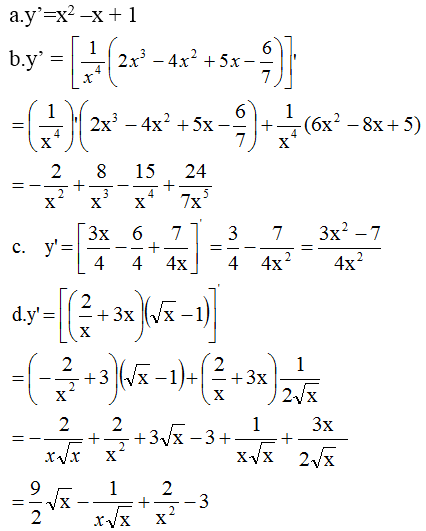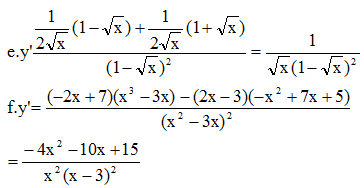Hãy nhập câu hỏi của bạn vào đây, nếu là tài khoản VIP, bạn sẽ được ưu tiên trả lời.

a) Cách 1: y' = (9 -2x)'(2x3- 9x2 +1) +(9 -2x)(2x3- 9x2 +1)' = -2(2x3- 9x2 +1) +(9 -2x)(6x2 -18x) = -16x3 +108x2 -162x -2.
Cách 2: y = -4x4 +36x3 -81x2 -2x +9, do đó
y' = -16x3 +108x2 -162x -2.
b) y' = .(7x -3) +
(7x -3)'=
(7x -3) +7
.
c) y' = (x -2)'√(x2 +1) + (x -2)(√x2 +1)' = √(x2 +1) + (x -2) = √(x2 +1) + (x -2)
= √(x2 +1) +
=
.
d) y' = 2tanx.(tanx)' - (x2)' =
.
e) y' = sin
=
sin
.

\(x^{\alpha}\) với \(\alpha\) bất kì thuộc R bạn
nguyen thi khanh nguyen
a/ \(y=2x^3-5\sqrt{x}+5x^{-3}\Rightarrow y'=6x^2-\frac{5}{2\sqrt{x}}-15x^{-4}=6x^2-\frac{5}{2\sqrt{x}}-\frac{15}{x^4}\)
\(\Rightarrow y'\left(4\right)=\frac{24241}{256}\)
b/ \(y=3x^3-x^2+6x-2\Rightarrow y'=9x^2-2x+6\)
\(\Rightarrow y'\left(4\right)=142\)
c/ \(y'=\frac{-11}{\left(3x-1\right)^2}\Rightarrow y'\left(4\right)=\frac{-11}{11^2}=-\frac{1}{11}\)

Ta xét bảng sau đây :
x 1 2 x-1 2 x-2 f(x) 1-x 4-2x 5-3x x-1 4-2x 3-x x-1 2x-4 3x-5
Ta có ngay với \(x\ne1\) và \(x\ne2\)
\(f'\left(x\right)=\begin{cases}-3;x< 1\\-1;1< x< 2\\3;x>2\end{cases}\)
Bây giờ xét tại \(x=1\), ta có
\(\lim\limits_{\Delta x\rightarrow0^+}\frac{f\left(1+\Delta x\right)-f\left(1\right)}{\Delta x}=\lim\limits_{\Delta x\rightarrow0^+}\frac{3-\left(1+\Delta x\right)-2}{\Delta x}=\lim\limits_{\Delta x\rightarrow0^+}\frac{-\Delta x}{\Delta x}=-1\)
\(\lim\limits_{\Delta x\rightarrow0^-}\frac{f\left(1+\Delta x\right)-f\left(1\right)}{\Delta x}\ne\lim\limits_{\Delta x\rightarrow0^-}\frac{5-3\left(1+\Delta x\right)-2}{\Delta x}=\lim\limits_{\Delta x\rightarrow0^-}\frac{-3\Delta x}{\Delta x}=-3\)
Như vậy \(\lim\limits_{\Delta x\rightarrow0^+}\frac{f\left(1+\Delta x\right)-f\left(1\right)}{\Delta x}\ne\lim\limits_{\Delta x\rightarrow0^-}\frac{f\left(1+\Delta x\right)-f\left(1\right)}{\Delta x}\)
Nghĩa là không tồn tại đạo hàm của \(f\left(x\right)\) tại \(x=1\)
Tương tự không tồn tại đạo hàm của \(f\left(x\right)\) tại \(x=2\)


\(y'=-3x^2-6x+m\Rightarrow y''=-6x-6\)
\(y''=0\Leftrightarrow-6x-6=0\Leftrightarrow x=-1\notin\left[0;1\right]\)
\(\left\{{}\begin{matrix}y'\left(0\right)=m\\y'\left(1\right)=m-9\end{matrix}\right.\Rightarrow^{max}_{\left[0;1\right]}y'=y'\left(0\right)=m\)
\(\Rightarrow m=10\)
Hoàng Hải Yến hình như có chỗ nào sai sai